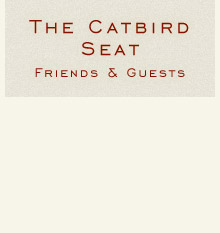Emdashes—Modern Times Between the Lines
The Basics:
About Emdashes | Email us
Ask the Librarians
Best of Emdashes: Hit Parade
A Web Comic: The Wavy Rule
Features & Columns:
Headline Shooter
On the Spot
Looked Into
Sempé Fi: Cover Art
What's in a Trope? We Find Clues in Cartoons From Vintage Gourmets
Filed under: The Catbird Seat: Friends & Guests Tagged: books, Cartoon Caption Contest, cartoons, food, John McPhee, Jonathan Raban, Jonathan Taylor, nonfiction

From our friend Jonathan Taylor, who recently wrote a meditation on John McPhee and the evolution of greenmarkets:
“The great urban visual art is the cartoon,” Jonathan Raban writes in his 1974 book Soft City. The book is a meditation on the idea that cities are where strangers live. A common observation, perhaps, but so ruling a reality that after fifteen years of living in New York City, I think I am only now really awakening to this philosophy’s peculiarity and implications.
And that bears out Raban’s point: cities permit, and require, their dwellers to inhabit the most private worlds, which they then interpret as “life” itself. Raban describes the “person-spotting” skills developed in the city to make instant judgments of strangers—who will remain strangers—through the most immediate visual emblems: “accents, clothes, brands of car, my reactions to endomorphic or ectomorphic figures.” Hence, the cartoon.
The acknowledgments in Soft City note that parts of the book had previously been published in Encounter, London Magazine and The Listener, all now-defunct exemplars of the 20th-century magazine. And the “New Yorker cartoon,” with its stock characters denoted with ideographic brushstrokes—the lawyer, the psychiatrist, the boozer at the bar—is itself the near-lone survivor of a genre once common to that stripe of magazine.
There’s a nice reminder of this in Gourmet’s online gallery of some of the single-panel cartoons that ran in every issue of the magazine in the 1940s and 1950s. They have their own subset of spottable strangers: short-order cooks, ladies who lunch, and waiters in jackets (back when, as I wrote here recently, “foodies” were “gourmets”). Some are as deflating as a weak New Yorker caption contest winner, but it’s key for a magazine historian or admirer to understand what met rigorous standards of semifunniness in the past. The “punch line” to this one gives satisfaction of perhaps more of the puzzle-solving kind than the humorous one. And this cartoon is a downright prescient take on what Raban calls the “emporium of styles,” the city in which classes are no longer defined by what they produce, but by what they consume.




Comments
Thanks for the link to the Gourmet cartoons! I never knew they’d run cartoons at one time. I found cartoon/slide 13 puzzling - did she turn into a mermaid after she was shot? And did the woman who has the hat on come in to find her husband was making time with the mermaid and then shoot her? And what does this say, it occurs to me belatedly, about living with strangers in the city?
I assumed the latter interpretation, although the fellow’s look of surprise somehow seems to encompass her state of mermaidenhead.
Also, I take it that in six, “mixing drinks” means, combining (combibing?) different kinds of alcohol?